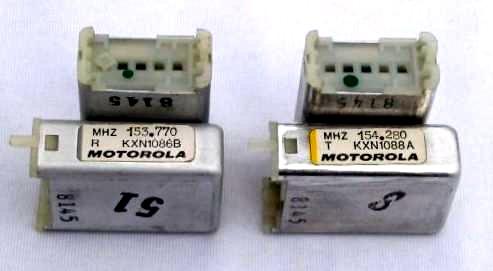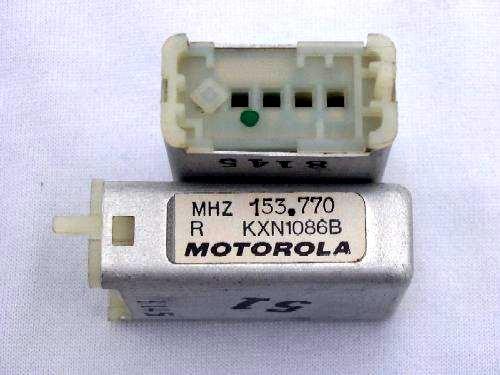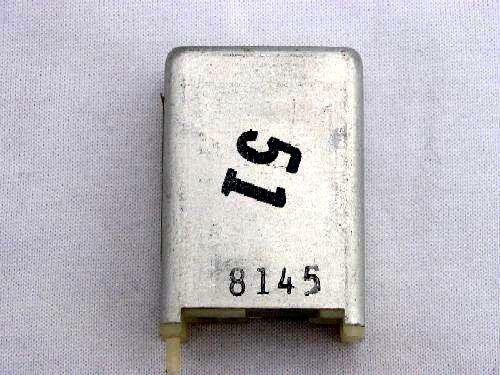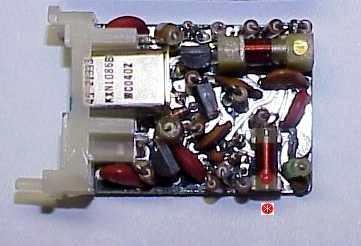Up one level (MSR2000 index)
Back to Home
By Mike Morris WA6ILQ
|
Up one level (Mitrek index) Up one level (MSR2000 index) Back to Home |
Mitrek / MSR2000 Channel Elements By Mike Morris WA6ILQ |
|
Comments and additional material are welcome
(even "Hey - you've got a typo at..." messages)
 |
|
Note that the receive elements (on the left) have the leftmost pin blocked with a plastic peg
(i.e. they have 4 active pins) while the transmit elements (on the right) have 5 pins. |
 |
|
Here's a closeup of the blocked pin in the receive element. Also visible (on the extreme left
of the element and in the other photos) is the plastic pin that fits into a hole in the PC
board so that the element can't be inserted backwards. |
 |
| The "8145" stamp on the lower part of the element housing is a standard format date code (i.e. YYWW where YY is the year, and WW is the week), and indicates that this element was crystaled and tested during the 45th week of 1981 i.e. around the first week in November. |
As visible in the top photo is the Mitrek / MSR channel element part number and frequency label. Note that one label does both duties. If it is missing, make sure you verify the channel element is operational in the band you want... and then mark the element housing with the appropriate number - "1085", "1086", "1087", "1088", "1095" or "1112" - using a "Sharpie" type pen. I learned the hard way: I once purchased a low-band Mitrek that arrived with a pair of UHF elements installed that had the labels very carefully removed... Fortunately I was able to find someone that wanted a pair of 415 MHz elements and had extra low band elements.
The tables below are from the Mitrek manuals that I have in my file cabinets. There may be additional elements that work in a Mitrek. If you know of any others, please drop an email to the address at the end of this writeup.
| Mitrek Mobile | ||
| Band | Element | Formula (see note 1) |
| 29-50 MHz 2 | Receive = KXN1085 | Crystal = (Channel frequency + 10.7 MHz) / 3 |
| Transmit = KXN1087 | Crystal = (Channel frequency) / 3 | |
| 136-174 3 | Receive = KXN1086B | Crystal = (Channel frequency - 10.7 MHz) / 3 |
| Transmit = KXN1088 | Crystal = Channel frequency / 12 | |
| 406-512 3 | Receive = KXN1086B | Crystal = (Channel frequency - 10.7 MHz) / 9 |
| Transmit = KXN1088 | Crystal = Channel frequency / 36 | |
| 800 MHz 4 | RX / TX = KXN1103A or B | Pretty much useless to hams |
| MSR2000 Base or repeater See above for crystal formulas |
|||
| Band | Accuracy 5 | Receive | Transmit |
| 29-50 MHz | As far as I have been able to determine, Moto never made a low band MSR2000. Moto sales has a hole in their product line table, and Moto parts cannot come up with a manual part number. It appears that if a customer wanted one the salesmen specified a low band MICOR station. | ||
| 136-174 and 406-512 3 |
0.0005% | KXN1086B | KXN1088B |
| 0.0002% | KXN1112A | KXN1095A | |
Notes:
1) The Mitrek is normally a low injection radio. Occsionally you will find
one that is high injection (i.e. the "-10.7 MHz" in the formulas is really
+10.7 MHz). The formulas for the MSR are the same as for the Mitrek,
assuming that the MSR has the 10.7 MHz IF frequency. More on this concern below.
2) Yes, the book actually specifies that for the Mitrek its Low Band is 29.7 MHz
to 50 MHz, not 30-50 MHz.
3) The 136-174 and 406-512 MHz radios use the exact same elements - the only difference
is what is typed on the frequency label.
4) The 800 MHz Mitrek uses a single element and multiplier chain both
as a local oscillator for the receiver, and as the exciter. This works
because the IF frequency is equal to the repeat offset. The radio is
pretty much useless to a ham except as a doorstop. I'm listing the KXN1103
element only so you will know what the number is in case you stumble across
any at a hamfest.
5) The specified accuracy only holds if you have the crystal manufacturer
temperature compensate the elements. See this article:
Why should you really spend $50 to
re-crystal a channel element or ICOM?.
The 0.0002% and 0.0005% elements use different crystals. If you are going to recrystal your own elements make very, very sure which elements you have, and order the crystals for those elements. If you get it wrong (i.e. order for a KXN1088 when you really have a KXN1095) you will be between 30 kHz and 40 kHz off at highband, and between 90 kHz and 120 kHz off at UHF. You cannot "pad" the crystal to compensate - you will have to acquire an element to match the crystal, or reorder the crystal to match the element that you actually have. If you ship the element to the rock house to be recrystalled you won't have to worry about this.
Note that the channel elements have a tripler inside them. In other words, a frequency counter connected to the output pin of the element will usually read three times the crystal frequency (sometimes enough fundamental leaks through so that the counter reads it, but not often).
The RF side of the MSR2000 is essentially a Mitrek mobile main board sliced into receive and exciter halves, and packaged into separate modules or housings. The duplex versions have lots of filtering. Couple those modules to a MICOR station control shelf, albeit with a few changes such as better connectors. There are a wide range of parts that interchange with a Mitrek mobile - two are channel elements and receiver IF filters.
One of the options for the MSR was a second receiver. To avoid interaction with the main receiver the designers moved the IF in the second receiver to 10.8 MHz (from 10.7 MHz). This 10.8 MHz IF was also used in the main receiver of a second MSR in the same cabinet. 95% of the MSR receivers out there use a 10.7 MHz IF, but as expensive as good crystals are these days it's worth checking before you order - that MSR receiver module you bought on ebay could have been someone's elses second receiver. The channel element for the second receiver was either a KXN1086BA (0.0005%) or a KXN1112BA (0.0002%). There was no difference inside the element between a B and a BA, the changed part number just clued the rock chippers to cut for the alternate 10.8 MHz IF frequency.

Some folks choose to recrystal their own elements... if you open an element you will frequently find a second adjustment that is normally hiden by the element housing. After the new crystal is installed plug the element into the radio and adjust the hidden coil. If you have a Moto test set select the local oscillator injection position (position 6) and tune for maximum. If you do not have a test set connect a 50ua meter between receiver socket pin 6 and ground. Just for completeness, the coil at the top right of the photo is the adjustment that is used to set the element on frequency. Wait until the aluminum cover is back on the element and it is reinstalled in the radio before you do the final on-frequency adjustment.
Contact Information:
The author can be contacted at: his-callsign // at // repeater-builder // dot // com.
Back to the top of the page
Up one level (Mitrek index)
Up one level (MSR2000 index)
Back to Home
Revision History:
29-Jan-2008 - Typo correction
05-Mar-2006 - added the 800 MHz element
05-Sep-2005 - added the crystal formulas
15-Mar-2007 - Added the paragraph about the differences between the 0.0005% and 0.0002%
crystals and the fact that the wrong crystal will be off frequency (based on an email from
K4IDC listing his experiences)
21-Mar-2007 - New photos
30-Mar-2007 - Typo correction
07-May-2012 - Typo Correction
This page originally posted on 04-11-2005
Good luck and after you get your Mitrek or MSR2000 going please drop me an email at (callsign) at repeater-builder.com and let me know how things went. Sometimes I wonder if anybody reads these missives to the masses...
If you see something above that is vague, missing (or outright wrong), please let me know! It's input from the readers that make these writeups better - I've probably either totally missed or shortchanged topics and /or subtopics that really need to be covered.
Copyright (c) Michael R. Morris WA6ILQ 2002, and the date of the last update.
This web page, this web site, the information presented in and on its pages and in these modifications and conversions is © Copyrighted 1995 and (date of last update) by Kevin Custer W3KKC and multiple originating authors. All Rights Reserved, including that of paper and web publication elsewhere.